UTC Fire and Security Americas WEDGE180 IR Network Camera User Manual
UTC FIRE & SECURITY AMERICAS CORPORATION, INC IR Network Camera
User Manual

TruVision
11/31
Series
Wi-Fi IP
Camera Installation
Guide
P/N 1072907-EN • REV B • ISS 24APR15

Copyright
© 2015 United Technologies Corporation,
Interlogix is part of UTC Building & Industrial Systems, a unit of United
Technologies Corporation. All rights reserved.
Trademarks and patents
Trade names used in this document may be trademarks or registered trademarks
of the manufacturers or vendors of the respective products.
Manufacturer
Interogix
2955 Red Hill Avenue, Costa Mesa, CA 92626-5923, USA
Authorized EU manufacturing representative:
UTC Fire & Security B.V.
Kelvinstraat 7, 6003 DH Weert, The Netherlands
Certification
N4131
This equipment has been tested and found to comply with the limits for a Class B
digital device, pursuant to Part 15 of FCC Rules. These limits are designed to
provide reasonable protection against harmful interference in a residential
installation. This equipment generates, uses, and can radiate radio frequency
energy and, if not installed and used in accordance with the instructions, may
cause harmful interference to radio communications. However, there is no
guarantee that interference will not occur in a particular installation. If this
equipment does cause harmful interference to radio or television reception, which
can be determined by turning the equipment off and on, the user is encouraged
to try to correct the interference by one or more of the following measures:
1. Reorient or relocate the receiving antenna.
2. Increase the separation between the equipment and receiver.
3. Connect the equipment into an outlet on a circuit different from that to which
the receiver is connected.
4. Consult the dealer or an experienced radio technician for help.
CC Caution
To assure continued compliance, use only shielded interface cables when
connecting to computer or peripheral devices. Any changes or modifications not
expressly approved by the party responsible for compliance could void the user’s
authority to operate the equipment.
This device complies with Part 15 of the FCC Rules. Operation is subject to the
following two conditions:
(1) This device may not cause harmful interference
(2) This Device must accept any interference received, including interference that
may cause undesired operation.
Any changes or modifications not expressly approved by the party responsible for
compliance could void the user’s authority to operate the equipment.
Federal Communication Commission (FCC) Radiation Exposure Statement
This equipment complies with FCC radiation exposure set forth for an
uncontrolled environment. In order to avoid the possibility of exceeding the FCC
radio frequency exposure limits, human proximity to the antenna shall not be less
than 20 cm (8 inches) during normal operation.
CAN ICES-3 (B)/NMB-3(B)
This device complies with Industry Canada licence-exempt RSS standard(s).
Operation is subject to the following two conditions:
(1) this device may not cause interference, and
(2) this device must accept any interference, including interference that may
cause undesired operation of the device.
Le présent appareil est conforme aux CNR d'Industrie Canada applicables aux
appareils radioexempts de licence. L'exploitation est autorisée aux deux
conditions suivantes :
(1) l'appareil ne doit pas produire de brouillage, et
(2) l'utilisateur de l'appareil doit accepter tout brouillage radioélectrique subi,
même si le brouillage est susceptible d'en compromettre le fonctionnement.
Under Industry Canada regulations, this radio transmitter may only operate using
an antenna of a type and maximum (or lesser) gain approved for the transmitter
by Industry Canada. To reduce potential radio interference to other users, the
antenna type and its gain should be so chosen that the equivalent isotropically
radiated power (e.i.r.p.) is not more than that necessary for successful
communication.
Conformément à la réglementation d'Industrie Canada, le présent émetteur radio
peut
fonctionner avec une antenne d'un type et d'un gain maximal (ou inférieur)
approuvé pour l'émetteur par Industrie Canada. Dans le but de réduire les
risques de brouillage radioélectrique à l'intention des autres utilisateurs, il faut
choisir le type d'antenne et son gain de sorte que la puissance isotrope rayonnée
équivalente (p.i.r.e.) ne dépasse pas l'intensité nécessaire à l'établissement d'une
communication satisfaisante.
This equipment should be installed and operated with a minimum distance 20cm
between the radiator and your body
Cet équipement doit être installé et utilisé à une distance minimale de 20 cm entre
le radiateur et votre corps

R&TTE Compliance Statement
This equipment complies with all the requirements of DIRECTIVE 1999/5/CE OF
THE EUROPEAN PARLIAMENT AND THE COUNCIL OF 9 March 1999 on radio
equipment and telecommunication terminal Equipment and the mutual
recognition of their conformity (R&TTE). The R&TTE Directive repeals and
replaces in the directive 98/13/EEC (Telecommunications Terminal Equipment
and Satellite Earth Station Equipment) as of April 8, 2000.
Safety
This equipment is designed with the utmost care for the safety of those who
install and use it. However, special attention must be paid to the dangers of
electric shock and static electricity when working with electrical equipment. All
guidelines of this and of the computer manufacture must therefore be allowed at
all times to ensure the safe use of the equipment.
National Restrictions
This device is intended for home and office use in all EU countries (and other
countries following the EU directive 1999/5/EC) without any limitation except for
the countries mentioned below:
Country
Restriction
Reasons/remarks
Bulgaria
None
General authorization required for
outdoor use and public service
France
Outdoor use;
limited to 10 mW
e.i.r.p. within the
band 2454-
2483.5 MHz.
Military Radiolocation use. Refarming
of the 2.4 GHz band has been ongoing
in recent years to allow current relaxed
regulation. Full implementation
planned 2012
Luxembourg
None
General authorization required for
network and service supply(not for
spectrum).
Annex 3 B and A Wideband Data Transmission systems 2400.0-2483.5 MHz:
Country
Restriction
Reasons/remarks
Norway
Implemented
This subsection does not apply for the
geographical area within a radius of
20 km from the centre of Ny-Ålesund.
Italy
Implemented
The public use is subject to general
authorization by the respective service
provider.
Russian
Federation
Limited
implementation
1. SRD with FHSS modulation
1.1. Maximum 2.5 mW e.i.r.p.

1.2. Maximum 100 mW e.i.r.p.
Permitted for use SRD for outdoor
applications without restriction on
installation height only for purposes of
gathering telemetry information for
automated monitoring and resources
accounting systems. Permitted to use
SRD for other purposes for outdoor
applications only when the installation
height is not exceeding 10 m above
the ground surface. 1.3 maximum
100 mW e.i.r.p. indoor applications.
2. SRD with DSSS and other than
FHSS wideband modulation
2.1. Maximum mean e.i.r.p. density is
2 mW/MHz. Maximum 100 mW e.i.r.p.
2.2. Maximum mean e.i.r.p. density is
20 mW/MHz. Maximum 100 mW
e.i.r.p. It is permitted to use SRD for
outdoor applications only for purposes
of gathering telemetry information for
automated monitoring and resources
accounting systems or security
systems.
2.3. Maximum mean e.i.r.p. density is
10 mW/MHz. Maximum 100 mW
e.i.r.p. indoor applications.
Ukraine
Limited
implementation
e.i.r.p. ≤100 mW with built-in antenna
with amplification factor up to 6 dBi.
The following information shall also be included in the case of radio equipment
intentionally emitting radio waves:
(a) frequency band(s) in which the radio equipment operates;
(b) maximum radio-frequency power transmitted in the frequency band(s) in
which the radio equipment operates.
2012/19/EU (WEEE directive): Products marked with this
symbol cannot be disposed of as unsorted municipal waste
in the European Union. For proper recycling, return this
product to your local supplier upon the purchase of
equivalent new equipment, or dispose of it at designated
collection points. For more information see:
www.recyclethis.info.

2006/66/EC (battery directive): This product contains a
battery that cannot be disposed of as unsorted municipal
waste in the European Union. See the product
documentation for specific battery information. The battery
is marked with this symbol, which may include lettering to
indicate cadmium (Cd), lead (Pb), or mercury (Hg). For
proper recycling, return the battery to your supplier or to a
designated collection point. For more information see:
www.recyclethis.info.
Contact
information
For contact information, see www.interlogix.com or
www.utcfssecurityproducts.eu.
6 Installation Guide
Content
Introduction 7
Product overview 7
Installation 7
Installation environment 7
Package contents 8
Cable requirements 11
Camera description 11
Setting up the camera 12
Setting up Wi-Fi transmission 12
Accessing the SD card 19
Connecting a speaker 20
Mounting the wedge camera 21
Using the camera with a recorder 23
Using the camera with TruVision Navigator 24
Ensuring corrosion resistance 24
Specifications 25
TruVision IP wedge cameras 25
Pin definitions 26
Installation Guide 7
Introduction
Product overview
This is the installation guide for TruVision 11-31 Series Wi-Fi IP
camera models:
TVW-1103 (1.3MPX Wi-Fi, 2.8mm lens, Grey, PAL)
TVW-3103 (1.3MPX Wi-Fi, 2.8mm lens, Grey, NTSC)
TVW-1104 (1.3MPX Wi-Fi, 2.8mm lens, White, PAL)
TVW-3104 (1.3MPX Wi-Fi, 2.8mm lens, White, NTSC)
TVW-1105 (3MPX Wi-Fi, 2.8mm lens, Grey, PAL)
TVW-3105 (3MPX Wi-Fi, 2.8mm lens, Grey, NTSC)
TVW-1106 (3MPX Wi-Fi, 2.8mm lens, White, PAL)
TVW-3106 (3MPX Wi-Fi, 2.8mm lens, White, NTSC)
TVW-1116 (3MPX Wi-Fi, 6mm lens, White, PAL)
TVW-3116 (3MPX Wi-Fi, 6mm lens, White, NTSC)
Installation
This section provides information on how to install the cameras.
Installation environment
When installing your product, consider these factors:
• Electrical: Install electrical wiring carefully. It should be
done by qualified service personnel. Always use a proper
PoE switch or a 12 VDC UL listed Class 2 or CE certified
8 Installation Guide
power supply to power the camera. Do not overload the
power cord or adapter.
• Ventilation: Ensure that the location planned for the
installation of the camera is well ventilated.
• Temperature: Do not operate the camera beyond the
specified temperature, humidity or power source ratings.
The operating temperature of the camera is between -30
to +60°C (-22 to 140°F). Humidity is below 90%.
• Moisture: Do not expose the camera to rain or moisture,
or try to operate it in wet areas. Turn the power off
immediately if the camera is wet and ask a qualified
service person for servicing. Moisture can damage the
camera and also create the danger of electric shock.
• Servicing: Do not attempt to service this camera yourself.
Any attempt to dismantle or remove the covers from this
product will invalidate the warranty and may also result in
serious injury. Refer all servicing to qualified service
personnel.
• Cleaning: Do not touch the sensor modules with fingers. If
cleaning is necessary, use a clean cloth with some ethanol
and wipe the camera gently. If the camera will not be used
for an extended period of time, put on the lens cap to
protect the sensors from dirt.
Package contents
Check the package and contents for visible damage. If any
components are damaged or missing, do not attempt to use the
unit; contact the supplier immediately. If the unit is returned, it
must be shipped back in its original packaging.
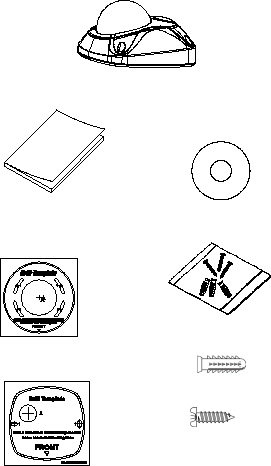
Installation Guide 9
IP wedge camera
Camera
Installation manual
CD with Configuration
Manual and TruVision Device
Finder
Template A for mounting
with the converter pan
Template B for mounting
without the converter pan
Screws
Drywall anchor
Φ7.5 x 24.5mm (3 pcs)
Screw M4
(4 x 25mm (3 pcs)
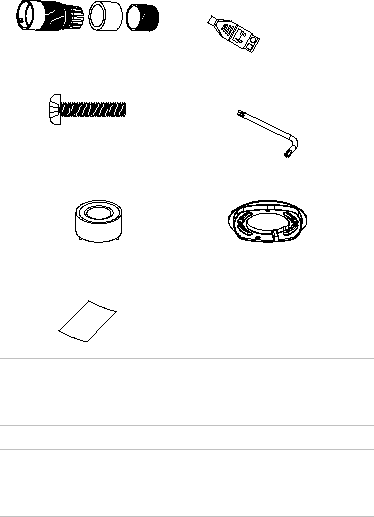
10 Installation Guide
Water joint: provide water
resistance to network
connection.
12 VDC connector: DC jack
socket to terminal connectors
with positive and negative
indicators.
Screws C: M4×8, 2pcs
Tamper-resistant
hex wrench
Lens alignment tool
Converter pan
WEEE and battery
disposal
CAUTION: Use direct plug-in UL listed power supplies marked
Class 2/CE certified or LPS (limited power source) of the
required output rating as listed on the unit.
CAUTION: Risk of explosion if battery is replaced by an
incorrect type. Dispose of used batteries according to the
instructions.
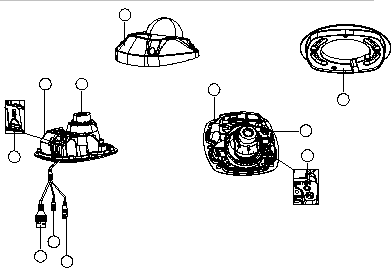
Installation Guide 11
Cable requirements
For proper operation, adhere to the following cable and power
requirements for the cameras. Category 5 cabling or better is
recommended. All network cabling must be installed according
to applicable codes and regulations.
Camera description
Figure 1: IP wedge camera
1. Camera cover/housing
2. Lens
3. SD card
4. Ethernet RJ45 PoE port
5. Power supply
6. Base
7. Alarm and Audio port
8. Reset/WPS button
9. Converter pan
10. Antenna
11. Microphone
9
2
1
6
8
7
3
5
4
1
0
1
1
12 Installation Guide
Setting up the camera
Note: If the light source where the camera is installed
experiences rapid, wide variations in lighting, the camera may
not operate as intended.
To quickly put the camera into operation:
1. Prepare the mounting surface.
2 Mount the camera using the appropriate fasteners. See
“Mounting the wedge camera” on page 21.
3. Set up the camera’s network and streaming parameters so
that the camera can be controlled over the network. For
further information, please refer to the “TruVision IP
Camera Configuration Manual”.
4. Program the camera to suit its location. For further
information, please refer to the “TruVision 11/31 Series IP
Camera Configuration Manual”.
Setting up Wi-Fi transmission
For setting up the Wi-Fi transmission, please refer to the
“TruVision 11/31 Series IP Camera Configuration Manual” for
details.
Wi-Fi transmission distance
The Wi-Fi transmission distance/range of the camera is
approximately 50 m (164 ft.) in open air applications.
Note: The transmission distance may vary due to the presence
of physical obstacles, such as trees, walls, elevators, fire doors,
furniture, etc. Avoid very solid walls and metallic objects in the
transmission path. Other Wi-Fi networks (for example Wi-Fi,
WiMAX) operating on 2.4 GHz and certain types of devices
(e.g., microwave oven point-to-point Wi-Fi transmission) can
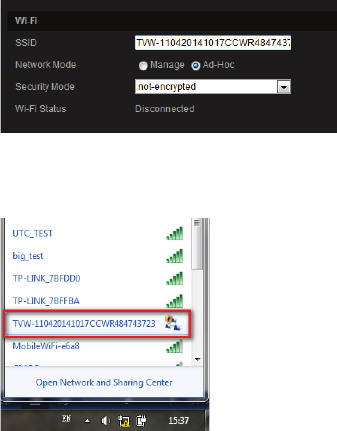
Installation Guide 13
cause interference with your network. The result would lead to a
reduction in transmission distance/range.
Access the camera via a Wi-Fi network (Ad-Hoc
mode)
Note: The camera is in Ad-Hoc mode by default. The SSID is
the serial number.
1. Power up the camera.
2. From your computer, search for the SSID that was set up
for the camera for Ad-Hoc mode. Select the SSID to
connect the camera.
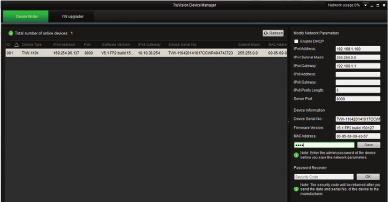
14 Installation Guide
3. When connected, open TruVision Device Finder or Device
Manager and change the IP address of the camera to that
of the same subnet of the router.
Note: The computer Wi-Fi IP address should also be in the
same subnet.
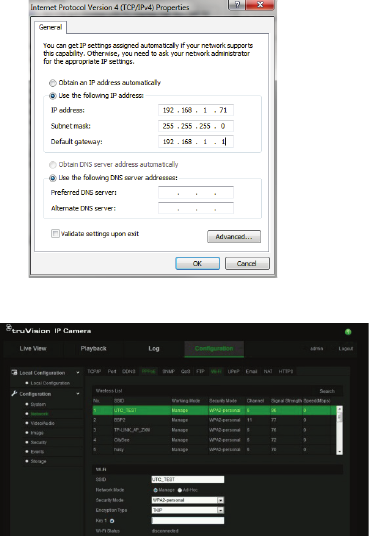
Installation Guide 15
4. Log on the camera via web browser and browse to the Wi-
Fi page.
5. Select the desired Wi-Fi and enter the key, if required.
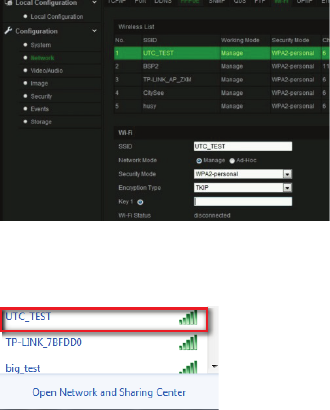
16 Installation Guide
6. Click Save to save the settings.
7. When the camera is connected to the router, the ad-hoc is
disconnected. On the laptop, select the Wi-Fi router and
connect it.
8. Open the device finder to check the WLAN IP address of
the camera. Log in to the camera to see live view.
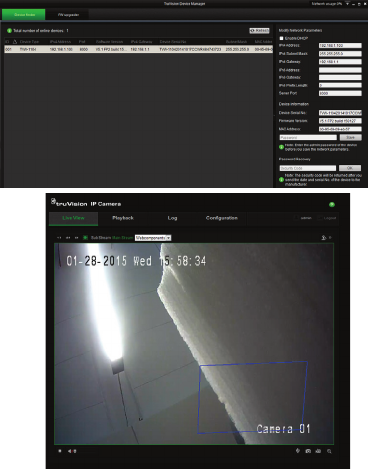
Installation Guide 17
Access the camera via a network cable
When configuring the Wi-Fi settings for the first time, connect
the camera to the router via a network cable and then open the
web browser to complete the Wi-Fi setup by clicking Save.
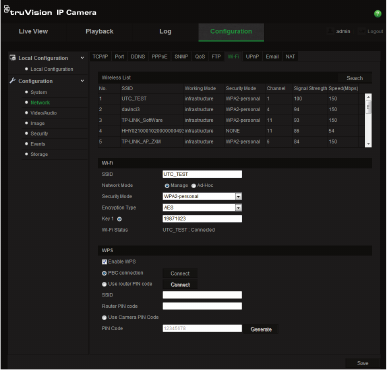
18 Installation Guide
When the Wi-Fi Status changes from “Disconnected” to
“Connected”, the Wi-Fi connection is set up successfully.
WPS
The camera provides WPS (Wi-Fi Protected Setup) feature to
easily set up a Wi-Fi connection to a Wi-Fi router.
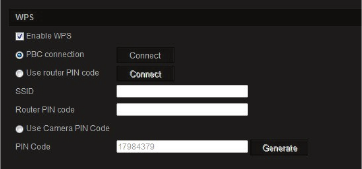
Installation Guide 19
PBC mode: Push the WPS button on the Wi-Fi router. The
WPS indicator will flash. (The WPS settings may be different
per device. Please refer to the Wi-Fi router User Manual for
details). Then check the PBC checkbox and click the Connect
button. The camera and the Wi-Fi router are automatically
connected.
PIN mode: The PIN code is printed on the Wi-Fi router device.
Enter the PIN code in the Router PIN Code bar and check the
Use Router PIN Code. Then click Connect to connect the
camera to the Wi-Fi router.
You can generate the PIN code on the camera side and
configure the Wi-Fi router to finish the connection setting.
(Please check the Wi-Fi router User Manual for details). Please
note that the PIN code expiration time is 120 seconds.
Accessing the SD card
Insert a Micro SD card with up to 64GB for local storage as a
backup in case, for example, the network fails (see Figure 1 on
page 11). The SD card is not supplied with the camera.
Video and log files stored on the Micro SD card can only be
accessed via the web browser. You cannot access the card
using TruVision Navigator or a recording device.
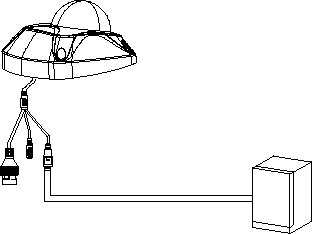
20 Installation Guide
Connecting a speaker
The camera has a built-in microphone to the collect audio input
signal. For audio output, please connect an external speaker to
the Audio Output and GND interface of the camera. The
speaker is not supplied with the camera.
Note: The speaker need be powered correctly with a power
supply. Please check the speaker specification and user
manual for more details.
Audio Output
GND
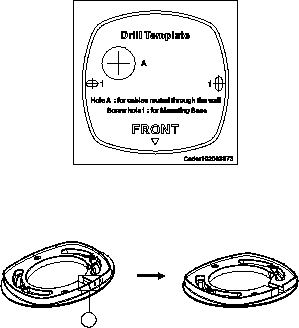
Installation Guide 21
Mounting the wedge camera
To mount the wedge camera on a wall or ceiling:
1. Drill the holes for the mounting hardware in the mounting
surface using the supplied drill template. To route the
cables from the base of the camera, drill a cable access
hole in the mounting surface.
2. Mount the converter pan to the mounting surface (optional).
Note: If required, you can remove the tab (A) on the side
of the converter pan to pass the cables through.
3. Loosen the screws with the tamper-resistant hex wrench
(supplied) to remove the camera cover.
A
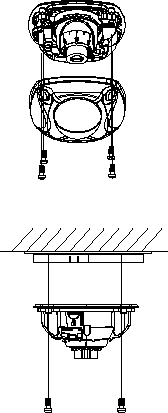
22 Installation Guide
4. Mount the camera base to the converter pan or mounting
surface, depending on the installation.
5. Use the supplied lens alignment tool to adjust the pan
[±30°], tilt [0 to 80°], and rotation direction [0 to 360°].
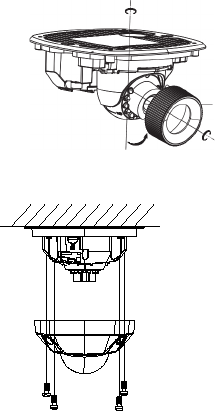
Installation Guide 23
Pan
Adjusting tool
Rotation
Tilt
6. Re-attach the dome cover to the camera.
Using the camera with a recorder
Please refer to the recorder user manuals for instructions on
connecting and operating the camera with these systems.
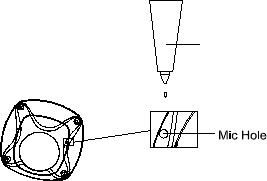
24 Installation Guide
Using the camera with TruVision Navigator
A camera must be connected to an Interlogix NVR or hybrid
DVR in order to be operated by TruVision Navigator. Please
refer to the TruVision Navigator user manual for instructions on
operating the camera with the TruVision Navigator.
Ensuring corrosion resistance
For normal outdoor or indoor applications, the camera has an
IP66 dust and water protection rating. Please follow the
installation instructions in the manual to mount the camera as
required.
When installing the camera in a corrosive environment, such as
marine ships, coastal sites, or chemical factories, please use
silicone sealant (purchased separately) to seal the microphone
hole. The typical cure time is about one to two hours in the
temperature range between 40 and 100°F (5 and 40°C).
silicone sealant

Installation Guide 25
The camera housing and hardware are designed and
manufactured to ensure corrosion protection. However, it is
necessary to seal the cable connection during the installation
work. Following all local codes, use electrical tape or a
corrosion-resistant conduit box to connect the cables as
required.
Note: Sealing the microphone hole impacts the sensitivity of
camera audio input.
Specifications
TruVision IP wedge cameras
Electrical
Voltage input
12 VDC, PoE (IEEE 802.3af)
Power consumption
Max. 5 W
Wi
-Fi parameters
Wi
-Fi standard IEEE802.11b/g/n
Frequency range
2.4 to 2.4835 GHz
Communication
bandwidth
Support 20/40 MHz
Security
64/128-bit WEP, WPA/WPA2, WPA-
PSK/WPA2-PSK, WPS
Transmission rate
11b: 11Mbps, 11g: 54Mbps, 11n: up
to 150Mbps
Transmission range
Up to 50 m
* It varies depending on the actual
working environment.

26 Installation Guide
Transmit
output power 11b: 17±1.5 dBm @ 11Mbps
11g: 14±1.5 dBm @ 54Mbps
11n: 12.5±1.5 dBm
Miscellaneous
Connectors
DC jack flying lead, RJ45 flying lead
Operating temperature
-30 to +60°C (-22°F to +140°F)
Dimensions (L × W × H)
98 × 89 × 329 mm
(3.86 ×3.49 × 12.94 in.)
Weight
407 g (0.89 lbs.)
Environmental rating
IP66
Pin definitions
There are eight wires on a standard UTP/STP cable and each
wire is color-coded. The following graphics show the pin
allocation and color of straight and crossover cable connection:
Figure 2: Straight-through cable
1 White/Orange
White/Orange 1
2 Orange Orange 2
3 White-Green White-Green 3
4 Blue Blue 4
5 White/Blue White/Blue 5
6 Green Green 6
7 White/Brown White/Brown 7
8 Brown Brown 8

Installation Guide 27
Figure 3: Cross-over cable
1 White/Orange
White/Orange 1
2 Orange Orange 2
3 White-Green White-Green 3
4 Blue Blue 4
5 White/Blue White/Blue 5
6 Green Green 6
7 White/Brown White/Brown 7
8 Brown Brown 8
Please make sure your connected cables have the same pin
assignment and color as above before deploying the cables in
your network.
28 Installation Guide